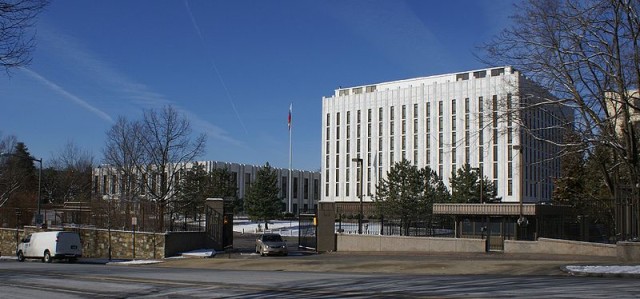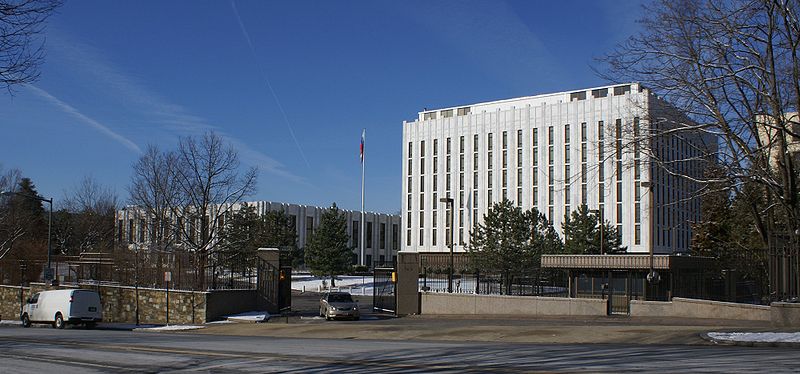
Soviet spies were very active in the American capital and were ingenious in how they went about their missions. The Americans were also very clever and used (counter-) measures to understand what the Soviet’s were doing and to prevent them from obtaining top-secret information.
John Galuardi, the regional administrator for the GSA in Washington, D.C. in the ’70s, was charged with determining the fate of the Mount Alto Veterans Hospital and its extensive properties, which totaled 12.5 acres between Wisconsin Ave. and Tunlaw St. NW in Glover Park. Galuardi was considering placing some government buildings there. The State Department, however, had different designs for the area and announced it would become home to the Soviet embassy.
The property was totally abandoned and dilapidated. Gualuardi’s concerns over maintenance were precluded by the arrival of some FBI agents at his office who wanted to remove all trees on the edges of the property prior to the arrival of Russian architects. The harder task, however, was making it appear as if no trees had ever been cut down.
Galuardi wrote a letter to inquire about how he was expected to cover up the accumulated sawdust from the chain saws. Instead of obfuscating the eyesore, Galuardi decided to clear the entire area where the trees had stood and make it seem as if grass seed was going to be planted. According to him, it seemed to have worked.
The FBI likely made this request out of a desire to monitor the newly founded Russian embassy. The U.S. embassy in Moscow was also host to a KGB intelligence gathering network, that included a plethora of monitoring devices which were installed by the Russians during the building’s construction. Would America do the same thing?
The answer to that question is that the Americans certainly would. Cut to January 1980, when Soviet officials found listening devices in the then newly constructed apartments for embassy workers on the Mount Alto site. These devices were so sensitive, in fact, that they allowed the FBI and CIA to hear “every sound, from a word spoken in the drawing room to a whisper in the bedroom or a splash of water in the toilet,” reported the Russian daily Izvestia.
That was only the beginning. Robert P. Hanssen, an FBI defector arrested in 2001 for espionage, informed his Russian handlers of the FBI’s surveillance of a certain Soviet establishment. In addition, he explained the specific location of the penetration device and what technology and methods were implemented.
The words “technical penetration” almost seem like a euphemism compared to the reality of the situation: a tunnel under the Soviet embassy constructed by the FBI and operated by the NSA, at the cost of probably hundreds of millions of dollars. With prior knowledge in hand, Russian officials publicized the event by demanding an American diplomat in Moscow, explain the presence of the tunnel.
The Russian foreign ministry issued a declaration that, if the reports proved to be true, this was a violation of international law regarding foreign diplomatic missions.
In response, a U.S. official speculated that the FBI/NSA effort had in fact been inspired by the Soviets themselves, who may or may not have been responsible for a tunnel filled with listening devices discovered beneath the U.S. embassy in Moscow in 1978.
Glover Park residents asked many times over where the tunnel below the Soviet embassy began. One possibility, is a house on Wisconsin Ave. facing the embassy’s entrance, seemed well positioned but would have required excavation below a busy road. Others speculated that the tunnel began under a house on Fulton St., the closest property to the embassy.
Charles Trew, espionage buff and Russian student, has obsessively studied the house on Fulton St. for the last 10 years. An Arlington resident, he frequents the house on a nearly constant basis and noticed no residents in his time.
In one of his most recent visits, Trew keenly noticed that the house had been gutted. Past the porta-potty in the driveway, missing roof, and fallen garage door, Charles noticed the curiously raised wooden floor in the garage located behind the house. Additionally, Charles pointed out the black glass windows on the garage windows. While some believed the house, located on a bluff, stood too high to make a tunnel feasible, Charles chose to further analyze the situation by consulting a tunneling expert. He learned that it is much easier to dig down than across, and has become convinced that this house is the located of the tunnel’s opening.
To Trew’s consternation, however, David Wise, who wrote a book on Hanssen, claimed the tunnel had been sealed with cement during his 2013 presentation at the Spy Museum. To add to the mystery, the remodeling company responsible for the house would not return calls and the FBI would not comment.
Image by Aaron Siirila, CC BY-SA 2.5, https://commons.wikimedia.org/w/index.php?curid=5142086
